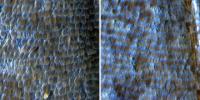
Yale University scientists have performed the first artificial selection on a structural color, using butterfly wings. This image shows a male Bicyclus anynana butterfly Yale University scientists have chosen the most fleeting of mediums for their groundbreaking work on biomimicry: They've changed the color of butterfly wings.
In so doing, they produced the first structural color change in an animal by influencing evolution. The discovery may have implications for physicists and engineers trying to use evolutionary principles in the design of new materials and devices.
The research appears this week in the journal Proceedings of the National Academy of Sciences.
"What we did was to imagine a new target color for the wings of a butterfly, without any knowledge of whether this color was achievable, and selected for it gradually using populations of live butterflies," said Antónia Monteiro, a former professor of ecology and evolutionary biology at Yale, now at the National University of Singapore.
In this case, Monteiro and her team changed the wing color of the butterfly Bicyclus anynana from brown to violet. They needed only six generations of selection.
Little is known about how structural colors in nature evolved, although researchers have studied such mechanisms extensively in recent years. Most attempts at biomimicry involve finding a desirable outcome in nature and simply trying to copy it in the laboratory.
"Today, materials engineers are making complex materials to perform multiple functions. The parameter space for the design of such materials is huge, so it is not easy to search for the optimal design," said Hui Cao, chair of Yale's Department of Applied Physics, who also worked on the study. "This is why we can learn from nature, which has obtained the optimal solutions in many cases via natural evolution over millions of years." 
Yale University scientists were able to change the color of a butterfly's wings in six generations. These images illustrate the change in wing color for the species Bicyclus anynana
Indeed, the scientists explained, natural selection algorithms can select for multiple characteristics simultaneously — which is standard operating procedure in the natural world.
The desired color for the butterfly wings was achieved by changing the relative thickness of the wing scales — specifically, those of the lower lamina. It took less than a year of selective breeding to produce the color change from brown to violet.
One reason Bicyclus anynana was chosen for the experiment, Monteiro said, was because it has cousin species that have evolved violet colors on their wings twice independently. By reproducing such a change in the lab, the Yale team showed that butterfly populations harbor high levels of genetic variation regulating scale thickness that lets them react quickly to new selective conditions.
"We just thought if natural selection has been able to modify wing colors in members of this genus of butterfly, perhaps so can we," Monteiro said.
Source : james.shelton@yale.edu
 Print Article
Print Article Mail to a Friend
Mail to a Friend
